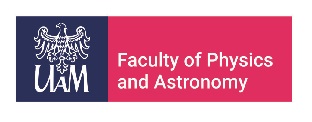
Dr. Grzegorz Chimczak
- Loc: wing G, second floor, room 280
- Email: chimczak@amu.edu.pl
- URL: http://zon8.physd.amu.edu.pl/~chimczak/
Scientific degrees
PhD in Physics – 2005
Research interests
keywords: PT symmetry, exceptional points, non-Hermitian physics, quantum teleportation, atom-cavity systems
Publications
2023 |
|
| 4. | Grzegorz Chimczak, Anna Kowalewska‑Kudłaszyk, Ewelina Lange, Karol Bartkiewicz, Jan Peřina Jr. The effect of thermal photons on exceptional points in coupled resonators. Scientific Reports, 13 , pp. 5859, 2023. @article{Chimczak2023, title = {The effect of thermal photons on exceptional points in coupled resonators.}, author = {Grzegorz Chimczak and Anna Kowalewska‑Kudłaszyk and Ewelina Lange and Karol Bartkiewicz and Jan Peřina Jr.}, url = {https://www.nature.com/articles/s41598-023-32864-2}, doi = {https://doi.org/10.1038/s41598-023-32864-2}, year = {2023}, date = {2023-04-11}, journal = {Scientific Reports}, volume = {13}, pages = {5859}, abstract = {We analyse two quantum systems with hidden parity-time ( PT ) symmetry: one is an optical device, whereas another is a superconducting microwave-frequency device. To investigate their symmetry, we introduce a damping frame (DF), in which loss and gain terms for a given Hamiltonian are balanced. We show that the non-Hermitian Hamiltonians of both systems can be tuned to reach an exceptional point (EP), i.e., the point in parameter space at which a transition from broken to unbroken hidden PT symmetry takes place. We calculate a degeneracy of a Liouvillian superoperator, which is called the Liouvillian exceptional point (LEP), and show that, in the optical domain, LEP is equivalent to EP obtained from the non-Hermitian Hamiltonian (HEP). We also report breaking the equivalence between LEP and HEP by a non-zero number of thermal photons for the microwave-frequency system.}, keywords = {}, pubstate = {published}, tppubtype = {article} } We analyse two quantum systems with hidden parity-time ( PT ) symmetry: one is an optical device, whereas another is a superconducting microwave-frequency device. To investigate their symmetry, we introduce a damping frame (DF), in which loss and gain terms for a given Hamiltonian are balanced. We show that the non-Hermitian Hamiltonians of both systems can be tuned to reach an exceptional point (EP), i.e., the point in parameter space at which a transition from broken to unbroken hidden PT symmetry takes place. We calculate a degeneracy of a Liouvillian superoperator, which is called the Liouvillian exceptional point (LEP), and show that, in the optical domain, LEP is equivalent to EP obtained from the non-Hermitian Hamiltonian (HEP). We also report breaking the equivalence between LEP and HEP by a non-zero number of thermal photons for the microwave-frequency system. |
| 3. | Jan Wójcik, Grzegorz Chimczak Electrically coupled optomechanical cavities as a tool for quantum nondemolition measurement Physics Letters A, 490 , pp. 129187, 2023, ISSN: 0375-9601. @article{WOJCIK2023129187, title = {Electrically coupled optomechanical cavities as a tool for quantum nondemolition measurement}, author = {Jan Wójcik and Grzegorz Chimczak}, url = {https://www.sciencedirect.com/science/article/pii/S0375960123005674}, doi = {https://doi.org/10.1016/j.physleta.2023.129187}, issn = {0375-9601}, year = {2023}, date = {2023-01-01}, journal = {Physics Letters A}, volume = {490}, pages = {129187}, abstract = {We present a new model of two electrically coupled optomechanical cavities. This model is based on the recently presented proposal [Physical Review A 103 (2021) 043509]. We found that coupling two optomechanical cavities via Coulomb force leads to cross-Kerr interactions between those cavities. We show that such systems may be ideal for a protocol of quantum non-demolition measurement because it is easy to eliminate the self-phase modulation effect. Moreover, nonlinearities in our model are based on easily adjustable parameters, and therefore, given recent experimental studies, we believe that experimental realization of a cross-Kerr interaction via Coulomb force coupling is feasible.}, keywords = {}, pubstate = {published}, tppubtype = {article} } We present a new model of two electrically coupled optomechanical cavities. This model is based on the recently presented proposal [Physical Review A 103 (2021) 043509]. We found that coupling two optomechanical cavities via Coulomb force leads to cross-Kerr interactions between those cavities. We show that such systems may be ideal for a protocol of quantum non-demolition measurement because it is easy to eliminate the self-phase modulation effect. Moreover, nonlinearities in our model are based on easily adjustable parameters, and therefore, given recent experimental studies, we believe that experimental realization of a cross-Kerr interaction via Coulomb force coupling is feasible. |
2022 |
|
| 2. | Jan Perina Jr, Adam Miranowicz, Grzegorz Chimczak, Anna Kowalewska-Kudłaszyk Quantum, 6 , pp. 883, 2022, ISSN: 2521-327X. @article{Perina2022quantum, title = {Quantum Liouvillian exceptional and diabolical points for bosonic fields with quadratic Ħamiltonians: Ŧhe Ħeisenberg-Langevin equation approach}, author = {Jan Perina Jr and Adam Miranowicz and Grzegorz Chimczak and Anna Kowalewska-Kudłaszyk}, url = {https://doi.org/10.22331/q-2022-12-22-883}, doi = {10.22331/q-2022-12-22-883}, issn = {2521-327X}, year = {2022}, date = {2022-12-10}, journal = {Quantum}, volume = {6}, pages = {883}, publisher = {Verein zur Förderung des Open Access Publizierens in den Quantenwissenschaften}, abstract = {Equivalent approaches to determine eigenfrequencies of the Liouvillians of open quantum systems are discussed using the solution of the Heisenberg-Langevin equations and the corresponding equations for operator moments. A simple damped two-level atom is analyzed to demonstrate the equivalence of both approaches. The suggested method is used to reveal the structure as well as eigenfrequencies of the dynamics matrices of the corresponding equations of motion and their degeneracies for interacting bosonic modes described by general quadratic Hamiltonians. Quantum Liouvillian exceptional and diabolical points and their degeneracies are explicitly discussed for the case of two modes. Quantum hybrid diabolical exceptional points (inherited, genuine, and induced) and hidden exceptional points, which are not recognized directly in amplitude spectra, are observed. The presented approach via the Heisenberg-Langevin equations paves the general way to a detailed analysis of quantum exceptional and diabolical points in infinitely dimensional open quantum systems.}, keywords = {}, pubstate = {published}, tppubtype = {article} } Equivalent approaches to determine eigenfrequencies of the Liouvillians of open quantum systems are discussed using the solution of the Heisenberg-Langevin equations and the corresponding equations for operator moments. A simple damped two-level atom is analyzed to demonstrate the equivalence of both approaches. The suggested method is used to reveal the structure as well as eigenfrequencies of the dynamics matrices of the corresponding equations of motion and their degeneracies for interacting bosonic modes described by general quadratic Hamiltonians. Quantum Liouvillian exceptional and diabolical points and their degeneracies are explicitly discussed for the case of two modes. Quantum hybrid diabolical exceptional points (inherited, genuine, and induced) and hidden exceptional points, which are not recognized directly in amplitude spectra, are observed. The presented approach via the Heisenberg-Langevin equations paves the general way to a detailed analysis of quantum exceptional and diabolical points in infinitely dimensional open quantum systems. |
| 1. | Shilan Abo, Grzegorz Chimczak, Anna Kowalewska-Kudłaszyk, Jan Peřina Jr, Ravindra W. Chhajlany, Adam Miranowicz Scientific Reports, 12 , pp. 17655, 2022, ISSN: 2045-2322. @article{shilan2022, title = {Hybrid photon–phonon blockade}, author = {Shilan Abo and Grzegorz Chimczak and Anna Kowalewska-Kudłaszyk and Jan Peřina Jr and Ravindra W. Chhajlany and Adam Miranowicz }, url = {https://www.nature.com/articles/s41598-022-21267-4}, doi = {https://doi.org/10.1038/s41598-022-21267-4}, issn = {2045-2322}, year = {2022}, date = {2022-10-21}, journal = {Scientific Reports}, volume = {12}, pages = {17655}, abstract = {We describe a novel type of blockade in a hybrid mode generated by linear coupling of photonic and phononic modes. We refer to this effect as hybrid photon–phonon blockade and show how it can be generated and detected in a driven nonlinear optomechanical superconducting system. Thus, we study boson-number correlations in the photon, phonon, and hybrid modes in linearly coupled microwave and mechanical resonators with a superconducting qubit inserted in one of them. We find such system parameters for which we observe eight types of different combinations of either blockade or tunnelling effects (defined via the sub- and super-Poissonian statistics, respectively) for photons, phonons, and hybrid bosons. In particular, we find that the hybrid photon–phonon blockade can be generated by mixing the photonic and phononic modes which do not exhibit blockade.}, keywords = {}, pubstate = {published}, tppubtype = {article} } We describe a novel type of blockade in a hybrid mode generated by linear coupling of photonic and phononic modes. We refer to this effect as hybrid photon–phonon blockade and show how it can be generated and detected in a driven nonlinear optomechanical superconducting system. Thus, we study boson-number correlations in the photon, phonon, and hybrid modes in linearly coupled microwave and mechanical resonators with a superconducting qubit inserted in one of them. We find such system parameters for which we observe eight types of different combinations of either blockade or tunnelling effects (defined via the sub- and super-Poissonian statistics, respectively) for photons, phonons, and hybrid bosons. In particular, we find that the hybrid photon–phonon blockade can be generated by mixing the photonic and phononic modes which do not exhibit blockade. |


